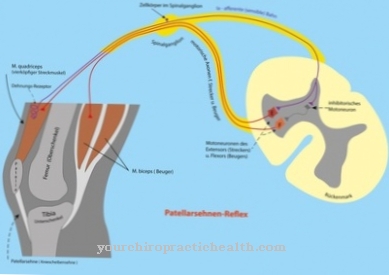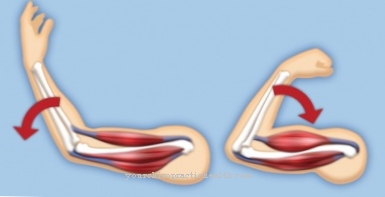Of the Blink sets in several times in a minute. Although it is rarely noticed consciously, its function is relevant to the overall health of the eye. Disturbances can cause unpleasant complaints.
What is the blink of an eye?

The blink of an eye is the unconscious closing and opening of the eyelid. Opening occurs immediately after closing, so the action is usually not noticed. It is mostly involuntary, but it can also be controlled.
The blink of an eye ensures that the tear fluid is evenly distributed and that dirt particles are removed through the tear duct. When you blink your eyelids, the upper and lower eyelids are stressed, but the upper part does most of the work in humans. The closing phase can be divided into three sections: acceleration, constant speed, acceleration. A blink of the eye has different lengths of time. Usually it varies between 50 and 125 milliseconds. If you are very tired, the blinking of the eye usually slows down.
Different muscles are decisive for the general mobility of the eyelids and the action itself. Overall, people blink about every four to six seconds. The frequency of blinking varies under different environmental conditions.
Function & task
The blink of an eye has elementary tasks. In this way he ensures the distribution of the tear film. Tears are usually only noticed when they emerge from the eye in a very sad or sometimes happy moment. The fluid is constantly produced by the lacrimal glands and serves the health of the eye. The film separates the cornea and eyelid. Without the even distribution through blinking, the opening and closing of the eyes would not go smoothly; instead, there would be unpleasant symptoms such as dryness and pain.
While sufficient fluid is available through the lacrimal glands, the blinking of the eye is responsible for ensuring that no dry areas appear. The tear film protects the eye from gusts of wind, bacteria and viruses. As soon as foreign bodies get into the eye, more tear fluid is produced and distributed by vigorous blinking. This is intended to flush the intruders out of the eye.
The cornea can also be supplied with all important nutrients via blinking and tears. Because the tissue has no connections to blood vessels, nutrition through the tear film is important. Gaps in the tear film due to suboptimal distribution are responsible for poor vision.
The transparent tear film on the cornea is also important for the refraction of light. The view, in turn, is based on light waves and their refractions. If gaps can be observed, even putting on glasses does not usually help because there is no optimal refraction of light. The blinking of an eye should take over the distribution of the tear film. This is irreplaceable for the smooth running of the visual process.
If threats such as strong winds or flying sand are imminent, the blinking of an eye acts as a direct protective function. Closing the eye can protect the sensitive cornea from injuries or intruders. Disturbances of the blinking of the eye result in different phenomena. If a disease has been diagnosed, the appropriate therapy should be given.
You can find your medication here
➔ Medicines for eye infectionsIllnesses & ailments
If the blinking function is restricted, there is a risk of unpleasant consequences. Thus, a doctor should be consulted as soon as the first symptoms become noticeable. Infrequent blinking causes the tear film to dry out. Although new tear fluid is formed, it is not distributed due to the lack of blinking. Those affected feel burning eyes and itching. The blinking of the eye can be uncomfortable at such a moment because the protective lubricant is missing and irritation occurs instead.
Working on the computer or cell phone often leads to the blinking of an eye relatively seldom. The eye is less protected from intruders and is usually perceived as dry. Furthermore, blinking disorders can result in excessively frequent blinking. For example, they are part of a tic disorder. Such habits mainly occur in children. Doctors estimate that around 30 percent of 8 to 14 year olds suffer from tic disorders. However, these often go away with age.
In the case of frequent blinking, it is a motor tic. The rapid movement takes place without any further meaning. Patients usually fail to suppress the action. A tic can arise primarily or secondary. A primary tic is caused by a physical component; secondary tics are manifested by another disease. Examples are trauma, brain inflammation or carbon monoxide poisoning. If there are multiple motor tics and at least one vocal tic, it is referred to as Tourette's syndrome. The cure for such a disease is not possible.
Very frequent or even permanent blinking also occurs in some patients with dystonia. Dystonia is manifested by involuntary muscle tension that persists over a long period of time and cannot be resolved independently. The trigger lies in the central nervous system. The disturbance does not take place in the muscle itself, but is controlled by the responsible brain areas. The frequent blinking of the eye is therefore a neurological disorder in dystonia. Periodic contractions occur, causing the eyelid to close and open without the affected person being able to control the process.
























.jpg)



